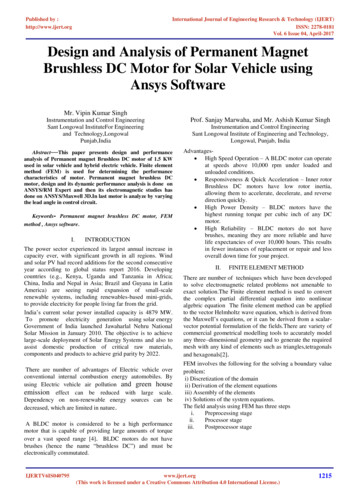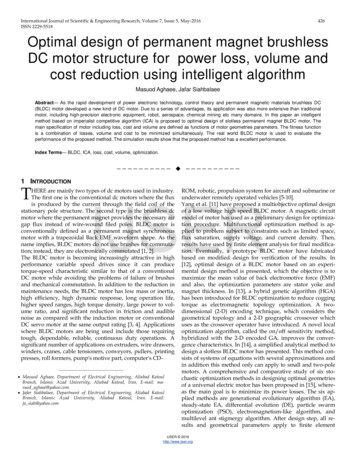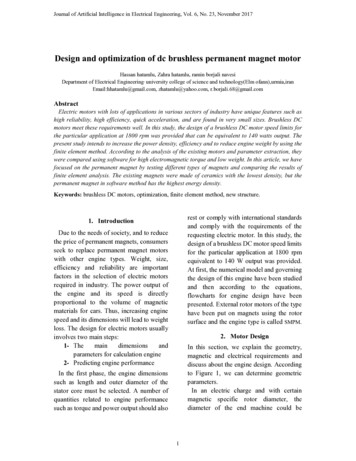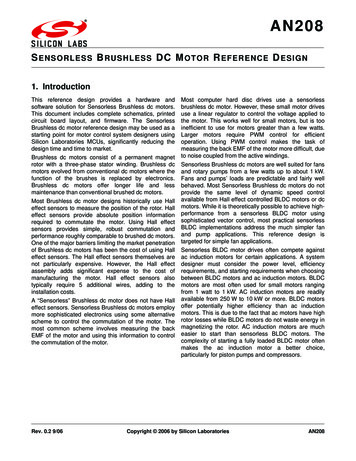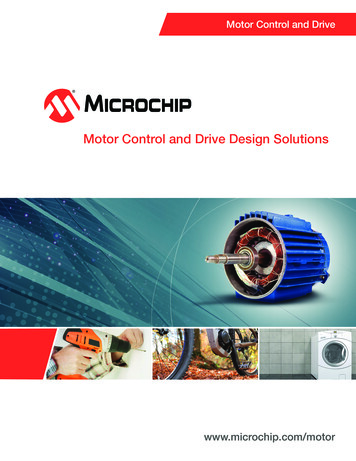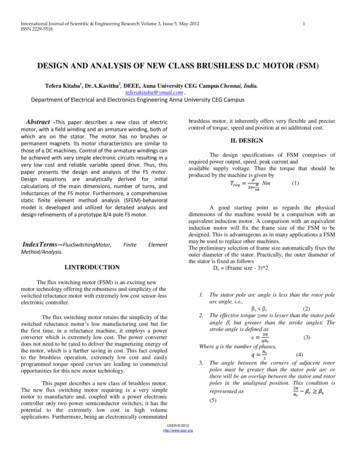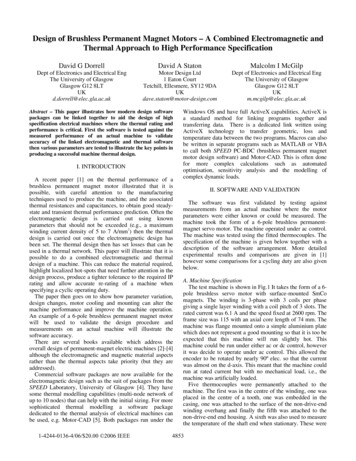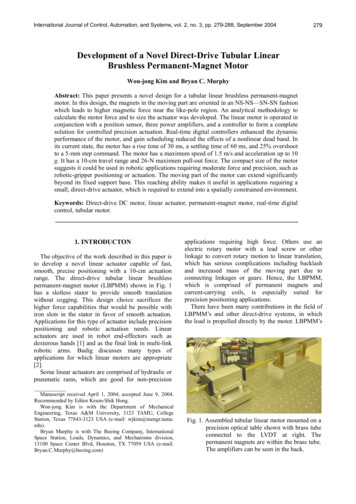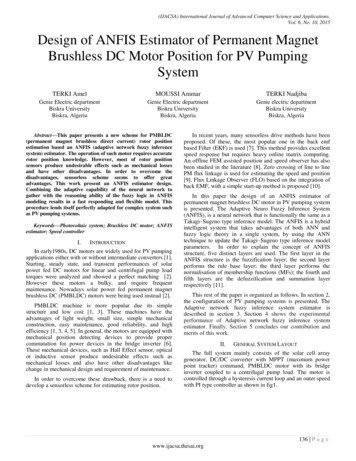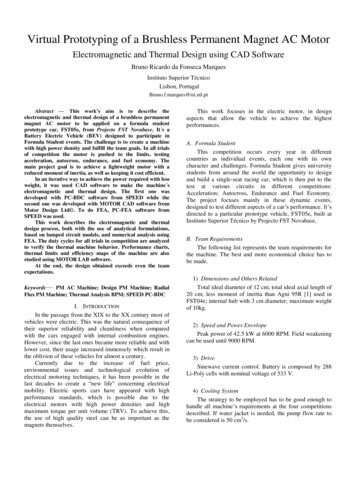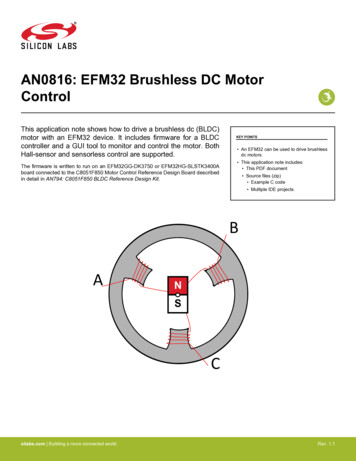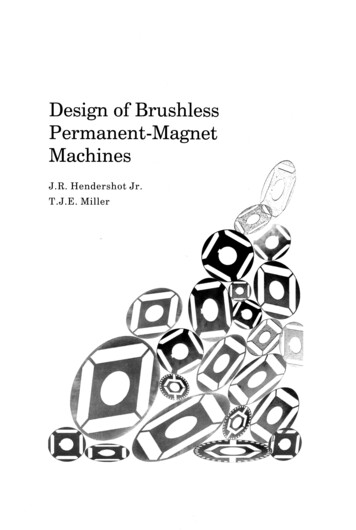
Transcription
Design of BrushlessPermanent-MagnetMachinesJ.R. Hendershot Jr.T.J.E. Miller
Contents1GENERAL INTRODUCTIONl1.1D e f i n i t i o n s a n d t y p e s of b r u s h l e s s m o t o r11.2Commutation41.3O p e r a t i o n of 3 - p h a s e b r u s h l e s s DC m o t o r1.3.11.3.21.3.31.4,.EMF waveformTorque and EMF constantsSpeed/torque characteristic71011Sinewave motors and generators1.4.11.4.25,16Phasor representationVoltage19221.5Practical considerations232MACHINE TYPES a n d APPLICATIONS252.1Machine configuration2.1.12.1.22.2,.Reasons for varietyClassification252527Radial-flux m a c h i n e s302.2.12.2.22.2.3303235Interior-rotor surface-magnet machinesInterior-rotor interior-magnet machines (IPM)Exterior-rotor machines . . . , , . . , , , ,2.3Axial-flux, l i n e a r a n d o t h e r m a c h i n e s372.4Gallery43
xivCONTENTS3BASIC DESIGN CHOICES653.1Machine and drive configuration673.1.13.1.23.23.43.567Squarewave drive673.1.1.2Sinewave drive68Salient-pole and nonsalient-pole machines683.1.2.1Nonsalient-pole machines683.1.2.2Salient-pole machines69N u m b e r of p h a s e s , p o l e s a n d s l o t s713.2.1713.2.23.3Squarewave and sinewave drives3.1.1.1Number of phases3.2.1.1Practical considerations713.2.1.2Number of phases in electrical systems723.2.1.3Number of phases in electrical machines753.2.1.4Distribution of coils between phases773.2.1.5Number of phases in inverters and rectifiers80Numbers of slots and poles82S i z i n g — t h e ABC of e l e c t r i c m a c h i n e d e s i g n873.3.187The output equationRotor Length/diameter ratioAirgap lengthFirst estimate of magnet dimensionsExploratory selection of magnet gradeMagnet overhangRotor yoke dimensionsStator ing the laminationsChoice of core plateStackingInsulating the slotsSlot-fill factorWinding and inserting the phase coilsVarnishingWinding with multiple-strand conductors97979798100101103104104
CONTENTS3.5.93.5.103.5.113.5.123.5.133.6N u m b e r of stator slots , ,Stator core d i m e n s i o n sStator tooth-tipsCogging a n d s k e wM a n a g e m e n t of end-turnsXV.,105105106107109Electrical design of nsIntegral-slot w i n d i n g sWindings for squarewave driveFractional-slot w i n d i n g s3.6.4.1A rule and two examples . . . .3.6.4.2The 12/10 motor; alternative windings3.6.4.3Pitch factor3.6.4.4Sinewave and squarewave motorsIrregular s l o t t i n gSystematic analysis of slot/pole ratio and w i n d i n g sWinding r e s i s t a n c e3.6.7.1Resistance calculation3.6.7.2Relationship between resistance and copper weight3.6.7.3Variation of resistance with temperature3.6.7.4AC resistance3.7Magnet r e t e n t i o n . . .1534FLUX, EMF, A N D TORQUE1574.1Permanent magnets and magnetic netic e q u i v a l e n t circuits4.1.1.1Airgap flux distribution4.1.1.2Clearance gap and equivalent magnet4.1.1.3Magnet divided by thin bracing bridgesDirect solution of Laplace / P o i s s o n e q u a t i o n sFinite-element methodEMF4.2.1178Formula4.2.1.14.2.1.2EMF constant of squarewave motorsEMF constant of sinewave motors179179180
xvi4.3CONTENTS4.2.2 BLV waveform method4.2.3 Toothflux waveform method181183Torque1854.3.14.4Torque constants1864.3.1.1Three-phase squarewave motor1864.3.1.2Sinewave motors187Torque a n d i n d u c t a n c e1904.4.14.4.2190193Salient-pole machines in phase variablesSalient-pole machines in dq axes4.5i-psi l o o p1974.6P r o p e r t i e s of t h e elliptical i-psi l o o p2035INDUCTANCE2095.1D e f i n i t i o n of i n d u c t a n c e a n d flux-linkage2105.1.12115.1.25.1.3Alternative definitions5.1.1.1di/dt2115.1.1.2Flux times turns211Other necessary laws of electromagnetismTurns squared2112125.2Important practical effects of i n d u c t a n c e2135.3Inductance components2145.4Airgap i n d u c t a n c e of surface-magnet m a c h i n e s2155.4.1 Airgap Self5.4.2 Airgap mutual5.4.3 Examples of airgap inductance calculation5.4.4 General case of airgap inductance2152172172215.5Slot-leakage i n d u c t a n c e2265.6End-winding leakage inductance233
CONTENTS5.7xviiI n d u c t a n c e s of s l o t l e s s ( a i r g a p ) w i n d i n g s2385.7.15.7.2241241Helical windingsLawrenson's method5.8Equivalent sine-distributed windings2425.9Synchronous inductance2435.9.1.Static measurement of synchronous inductance5.10 I n d u c t a n c e s of s a l i e n t - p o l e m a c h i n e s . . . .5.10.15.10.25.10.35.10.45.10.5dq-axis inductances from Park's transformSynchronous inductance coefficientsDirect calculation of synchronous inductanceDifferential leakage inductanceStatic measurement again2462472482522532582605.11 I n d u c t a n c e f r o m f i n i t e - e l e m e n t c a l c u l a t i o n s2625.12 M a g n e t i z a t i o n c u r v e s — b e y o n d i n d u c t a n c e2635.12.1 Magnetization curves in dqr-axes5.13 S a t u r a t i o n i n t h e dq-axismodel2662675.14 D e m a g n e t i z a t i o n2686273SQUAREWAVE DRIVEIntroduction6.1Three-phase bipolar drives6.1.16.1.26.1.36.1.46.1.56.1.6273.Waveforms and commutation sequencesCurrent regulationCommutation3-phase squarewave control strategiesAccumulations for mean and RMS currentsSelection of appropriate switching strategy274274279282286288289
xviii6.2CONTENTST r a n s i e n t analysis of 3-phase d r i v e s6.2.16.2.2Wye connection6.2.0.2Delta connection.,.2966.2.0.3Regeneration (over-running); no-load speed3016.2.0.4Phase advance3046.2.0.5Dwell control293306Salient-pole machines with squarewave driveBack-EMF sensing1- a n d 2 - p h a s e u n i p o l a r d r i v e s6.4Controller architecture7SINEWAVE 1325325The phasor diagram — motor 8349361367Torque/angle curvesThe voltage locus diagramT h e c i r c l e a n d ellipse d i a g r a m sC a l c u l a t i o n of t h e t o r q u e / s p e e d c h a r a c t e r i s t i cThe synchronous reluctance motorSummary — calculated characteristicsElectronic 383385389391396404T h e n e e d for c u r r e n t r e g u l a t i o nHistorical developmentO v e r v i e w of c o n t r o l l e r sSwitching representation by voltage vectorsSix-stepHysteresis-band current regulatordq W CRSine/triangle r a m p comparison.V o l t a g e PWM ( s i n e / t r i a n g l e )The synchronous regulatorSpace-vector controllerD i r e c t t o r q u e control (DTC)S u m m a r y of v o l t a g e c a p a b i l i t i e s
CONTENTSxix8k T A N D kE, A N D FIGURES-OF-MERIT4058.1Introduction4058.2k T & k E of s q u a r e w a v e a n d s i n e w a v e m o t o r / d r i v e 4358.38.4DC commutator motor and drive3-phase squarewave motor and drive3-phase sinewave motor and drive3-phase sinewave motor with squarewave drive3-phase squarewave motor with sinewave drive3-phase squarewave & sinewave systems comparedExample calculations (3-phase)2-phase squarewave motor and drive2-phase sinewave motor and drive2-phase sinewave motor with squarewave drive2-phase squarewave motor with sinewave drive2-phase squarewave & sinewave systems comparedF i g u r e s of m e r i 40kT and kEEfficiency and power factorTorque/Inertia ratioPower r a t eSpeed r a t e and mechanical time-constantMotor constant,The brushless PM motor in control Classical transfer function between voltage & speedBrushless DC motor model including inductanceClosed-loop feedback systemResponse of generic second-order systemDynamic braking
ons a n d ,451454No-load (open-circuit)Steady-state short-circuitPassive impedance loadVoltage regulation curvesConnection to an infinite busDiode rectifier loadActive rectification455456457459462464, . . . 467Short-circuit faults4689.3.19.3.2468472Classical analysisTransient Magnetic Field by Fourier TransformMULTIPLE-PHASE MACHINESIntroduction . . .10.1 P o l y p h a s e m a c h i n e s475475.47510.2 Multiplex w i n d i n g s47810.2.1 Reasons for using multiplex windings10.2.2 Fault-tolerant machines10.3 Analysis of m u l t i p l e x w i n d i n g s47948048110.3.1 Balance48410.4 Matrix analysis of t h e i n d u c t a n c e s48510.5 Torque49110.6 Steady-state o p e r a t i o n : p h a s o r diagram49310.7 S o l u t i o n m e t h o d — t r a n s i e n t49510.8 F i n i t e - e l e m e n t analysis.496
CONTENTS11xxiLINE-START MOTORS49711.1 I n t r o d u c t i o n49711.2 H i s t o r y50011.3 A n a l y s i s of p o l y p h a s e line-start m o t o r s.50311.3.1 Steady state11.3.2 A s y n c h r o n o u s o p e r a t i o n a n d s t a r t i n g11.3.3 Analysis of s y n c h r o n i z a t i o n50350651011.4 A n a l y s i s of s i n g l e - p h a s e l i n e - s t a r t m o t o r s51711.4.1 S t e a d y state; n o rotor cage11.4.2 Symmetrical c o m p o n e n t s.11.4.3 A s y n c h r o n o u s a n d starting performance51751953711.5 A d v a n c e d t o p i c s54211.5.1 Winding h a r m o n i c s11.5.2 Bar-pair-by-bar-pair m o d e l of t h e rotor cage11.5.3 C o n n e c t i o n circuits12LOSSES a n d COOLING542543550.55312.1 I n t r o d u c t i o n55312.2 J o u l e l o s s e s i n s t a t o r c o n d u c t o r s55412.3 Core l o s s e s555. .,12.3.1 The n a t u r e of core losses.12.3.2 Core loss properties of practical materials12.3.3 Calculation of core losses12.4 R o t o r e d d y - c u r r e n t l o s s e s12.4.1 Causes of rotor loss12.4.1.1Loss mechanisms in the magnets themselves12.4.1.2Resistance-or inductance-limited eddy-currents?12.4.1.3Hysteresis loss in magnets12.4.2 H a r m o n i c l o s s e s i n surface-magnet m a c h i n e s12.4.2.1Solution of the Complex Diffusion Equation555556559561561563564566568570
Exterior-rotor machine; 2-region model12.4.2.3Evaluation of the Exciting Harmonic Current Sheets12.4.2.4Balanced operation of 3-phase machines12.4.2.5Unbalanced operation of 3-phase machinesS e g m e n t e d m a g n e t s a n d finite-length effects12.4.3.1Circumferential segmentation.,12.4.3.2Simplified analysis of double segmentation12.4.3.3End-effect; segmentation in the axial direction12.4.3.4Russell and Norsworthy's method12.4.3.5Alternative analysis of segmented magnetsSlot ripple12.4.4.1Flux-dip-sweeping analysis of losses in thin can12.4.4.2Rotor can lossesHarmonic l o s s e s i n t h e IPM12.4.5.1Losses caused by time-harmonics in the current12.4.5.2Losses caused by flux-pulsations (slotting)Subtransient i n d u c t a n c e and time-constant12.4.6.1Effect of segmentation on subtransient reactance12.4.6.2Coupling coefficient of the IPM12.4.6.3Rotor time-constantF i n i t e - e l e m e n t calculation of 862963163563864264412.5 Windage, friction and bearing losses64712.6 Thermal analysis and cooling64812.6.112.6.212.6.312.6.412.6.5The n e e d for c o o l i n gCooling a n d efficiencyResponsibility for t e m p e r a t u r e riseHeat removalD e t a i l e d analysis of c o o l i n tion12.6.5.4Some rules of thumb12.6.5.5Internal temperature distribution12.6.5.6Thermal equivalent circuit12.6.5.7Some useful tables12.6.6 I n t e r m i t t e n t o p e r a t i o n648649650650652652653654655656657658660
xxiüCONTENTS13TESTING66713.1 I n t r o d u c t i o n66713.2 O b j e c t i v e s of t e s t i n g66713.3 B a s i c t e s t s a n d m e a s u r e m e n t s66813.3.1 Inertia66813.4 R e s i s t a n c e66913.5 E M F T e s t i n g67013.6 G e n e r a t o r l o a d t e s t i n g67113.7 M o t o r l o a d t e s t i n g67213.8 T o r q u e T e s t i n g13.8.1 Torque constant kT13.8.2 Cogging torque13.8.3 On-line estimation of torque using the i-psi loop67267267367413.9 T h e r m a l T e s t i n g67513.9.1 Thermal equivalent-circuit parameters67513.10 I n d u c t a n c e T e s t i n g67614681APPENDIX14.1 F r e q u e n t l y a s k e d q u e s t i o n s14.1.1 Machine Design Questions681,,.68114.1.1.1How do I decide the shape and size of the machine?68114.1.1.2How do I choose the number of slots and poles?68214.1.1.3How do I design the stator teeth and slots?68214.1.1.4How do I decide the number of turns?68414.1.1.5How do I decide the type of stator winding?68514.1.1.6How can I get a fractional number of turns/coil?68514.1.1.7How can I reduce the wire size?68514.1.1.8How can I reduce the inductance?68614.1.1.9How can I increase the inductance?68614.1.1.10How do I choose between SPM and IPM?686
xxivCONTENTS14.1.1.11How do I choose between exterior or interior rotor?68814.1.1.12When should I consider an axial-flux machine?68814.1.1.13How do I decide the rotor geometry?68914.1.1.14How can I reduce the inertia?69114.1.1.15How can I improve the torque linearity?69214.1.1.16How can I reduce torque ripple?69214.1.1.17How do I design a PM synchronous generator?69214.1.1.18How do I test a PM synchronous machine?69214.1.1.19Why isn't my measured kE equal to kT?69214.1.1.20How do I calculate the machine temperature?69214.1.1.21What are the main effects of temperature?69314.1.1.22How can I prevent demagnetization?69414.1.1.23How can I reduce the noise level?69514.1.1.24How can I reduce the motor cost?69514.1.1.25How about EMF ripple?69614.1.1.26How about a sine-EMF motor with squarewave drive? 6 9 614.1.2 P e r f o r m a n c e a n d Control Questions69714.1.2.1How can I increase efficiency?69714.1.2.2How can I increase power-factor?69814.1.2.3How can I get smooth rotation at low speed?69814.1.2.4How can I make the motor go faster?69914.1.2.5How can I get a more sinusoidal EMF waveform?70014.1.2.6How can I get a more sinusoidal current waveform?70014.1.2.7How do I avoid first-turn insulation failure?70014.1.2.8How do I avoid bearing currents?70214.1.2.9What causes machines to fail?70214.2 S a l i e n c y70314.3 Half t u r n s70614.4 S e r i e s a n d parallel i n d u c t a n c e s70914.5 Gearing71414.6 U n i t s of i n e r t i a71614.7 Calculation of i n e r t i a721Symbols, Abbreviations, and Explanatory Notes723Bibliography737Index755
Design of Brushless Permanent-Magnet Machines J.R. Hendershot Jr. T.J.E. Miller . Contents 1 GENERAL INTRODUCTION l 1.1 Definitions and types of brushless motor 1 1.2 Commutation , . 4 1.3 Operation of 3-phase
